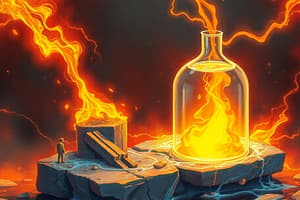Podcast
Questions and Answers
EASY What is a necessary condition for galvanic corrosion to occur?
EASY What is a necessary condition for galvanic corrosion to occur?
- When two identical metals contact each other
- When two dissimilar metals contact each other and are surrounded by an electrolyte (correct)
- When a metal is exposed to water
- When a metal is exposed to air
What happens to the anodic metal in a galvanic corrosion process?
What happens to the anodic metal in a galvanic corrosion process?
- It loses electrons and soluble metal ions are left behind (correct)
- It gains electrons and becomes more noble
- It remains unchanged
- It becomes more reactive
What is the role of the electrolyte in galvanic corrosion?
What is the role of the electrolyte in galvanic corrosion?
- To provide an electric field
- To accelerate the corrosion process
- To provide a pathway for electrons to flow (correct)
- To separate the two metals
What determines the rate of corrosion in galvanic corrosion?
What determines the rate of corrosion in galvanic corrosion?
What is the electromotive series?
What is the electromotive series?
What happens when a metal is under stress, such as in a bend or dent?
What happens when a metal is under stress, such as in a bend or dent?
Why do noble metals not readily corrode?
Why do noble metals not readily corrode?
What is stress corrosion cracking?
What is stress corrosion cracking?
Which metal has the highest electrochemical potential?
Which metal has the highest electrochemical potential?
What is the purpose of a sacrificial anode?
What is the purpose of a sacrificial anode?
What is the electrochemical potential of hydrogen?
What is the electrochemical potential of hydrogen?
What is the result of the reaction at the cathode in a zinc-copper galvanic cell?
What is the result of the reaction at the cathode in a zinc-copper galvanic cell?
What is the rule of thumb for the electrochemical potential difference between two materials to minimize galvanic corrosion?
What is the rule of thumb for the electrochemical potential difference between two materials to minimize galvanic corrosion?
What is the purpose of monitoring closed loop corrosion?
What is the purpose of monitoring closed loop corrosion?
What is the purpose of corrosion coupons?
What is the purpose of corrosion coupons?
What is the result of the reaction at the anode in a zinc-copper galvanic cell?
What is the result of the reaction at the anode in a zinc-copper galvanic cell?
What is the purpose of using borescopes in closed system corrosion monitoring?
What is the purpose of using borescopes in closed system corrosion monitoring?
MEDIUM What is the purpose of checking pressure drops and flow rates across heat exchangers and strainers?
MEDIUM What is the purpose of checking pressure drops and flow rates across heat exchangers and strainers?
What is the reason for galvanic corrosion occurrence even when there is only one type of metal present?
What is the reason for galvanic corrosion occurrence even when there is only one type of metal present?
What happens to the anodic metal in a galvanic corrosion process when it loses electrons?
What happens to the anodic metal in a galvanic corrosion process when it loses electrons?
What determines the direction of electron flow between two metals in a galvanic cell?
What determines the direction of electron flow between two metals in a galvanic cell?
What is the purpose of the electromotive series?
What is the purpose of the electromotive series?
What happens in stress corrosion cracking?
What happens in stress corrosion cracking?
Why do noble metals not readily corrode?
Why do noble metals not readily corrode?
What is the correlation between the electrochemical potential difference and the rate of corrosion?
What is the correlation between the electrochemical potential difference and the rate of corrosion?
What is the role of the electrolyte in galvanic corrosion?
What is the role of the electrolyte in galvanic corrosion?
In a galvanic corrosion process, which of the following ions are involved in the reaction at the cathode?
In a galvanic corrosion process, which of the following ions are involved in the reaction at the cathode?
What is the primary reason for using sacrificial anodes in a galvanic corrosion process?
What is the primary reason for using sacrificial anodes in a galvanic corrosion process?
Which of the following metals would be the most effective sacrificial anode in a galvanic corrosion process?
Which of the following metals would be the most effective sacrificial anode in a galvanic corrosion process?
What is the purpose of monitoring pH in closed system corrosion monitoring?
What is the purpose of monitoring pH in closed system corrosion monitoring?
What is the result of the reaction at the anode in a zinc-copper galvanic cell?
What is the result of the reaction at the anode in a zinc-copper galvanic cell?
Which of the following is a common method for preventing galvanic corrosion in industrial applications?
Which of the following is a common method for preventing galvanic corrosion in industrial applications?
What is the purpose of checking pipes and piping connections for leaks in closed system corrosion monitoring?
What is the purpose of checking pipes and piping connections for leaks in closed system corrosion monitoring?
What is the role of oxygen scavengers in closed system corrosion monitoring?
What is the role of oxygen scavengers in closed system corrosion monitoring?
Which of the following is a common method for monitoring corrosion in closed systems?
Which of the following is a common method for monitoring corrosion in closed systems?
What is the primary reason for replacing dissimilar piping with piping of similar materials in closed system corrosion monitoring?
What is the primary reason for replacing dissimilar piping with piping of similar materials in closed system corrosion monitoring?
HARD What is the primary reason why a pipe made of a single material can still undergo galvanic corrosion?
HARD What is the primary reason why a pipe made of a single material can still undergo galvanic corrosion?
What happens to the anodic metal when it loses electrons in a galvanic corrosion process?
What happens to the anodic metal when it loses electrons in a galvanic corrosion process?
What is the primary reason why zinc is often used as a sacrificial anode in galvanic corrosion prevention?
What is the primary reason why zinc is often used as a sacrificial anode in galvanic corrosion prevention?
What is the role of conductivity testing in closed system corrosion monitoring?
What is the role of conductivity testing in closed system corrosion monitoring?
What is the primary reason why noble metals do not readily corrode?
What is the primary reason why noble metals do not readily corrode?
What is the correlation between the electrochemical potential difference and the rate of corrosion in galvanic corrosion?
What is the correlation between the electrochemical potential difference and the rate of corrosion in galvanic corrosion?
What is the purpose of using borescopes in closed system corrosion monitoring?
What is the purpose of using borescopes in closed system corrosion monitoring?
What is the correlation between the electrochemical potential difference and the rate of corrosion?
What is the correlation between the electrochemical potential difference and the rate of corrosion?
What is the primary reason why a metal under stress, such as in a bend or dent, is more susceptible to corrosion?
What is the primary reason why a metal under stress, such as in a bend or dent, is more susceptible to corrosion?
What is the primary purpose of the electromotive series?
What is the primary purpose of the electromotive series?
Why is it important to replace dissimilar piping with piping of similar materials in closed system corrosion monitoring?
Why is it important to replace dissimilar piping with piping of similar materials in closed system corrosion monitoring?
What is the purpose of monitoring oxygen scavenger residuals in closed system corrosion monitoring?
What is the purpose of monitoring oxygen scavenger residuals in closed system corrosion monitoring?
What is the role of the electrolyte in galvanic corrosion?
What is the role of the electrolyte in galvanic corrosion?
What is the primary reason why a scratch or dent can cause galvanic corrosion in a metal?
What is the primary reason why a scratch or dent can cause galvanic corrosion in a metal?
What is the primary reason for using corrosion coupons in closed system corrosion monitoring?
What is the primary reason for using corrosion coupons in closed system corrosion monitoring?
What is the role of corrosion inhibitors in closed system corrosion monitoring?
What is the role of corrosion inhibitors in closed system corrosion monitoring?
What is the purpose of checking pipes and piping connections for leaks in closed system corrosion monitoring?
What is the purpose of checking pipes and piping connections for leaks in closed system corrosion monitoring?
What is the result of the reaction at the cathode in a zinc-copper galvanic cell?
What is the result of the reaction at the cathode in a zinc-copper galvanic cell?
Study Notes
Galvanic Corrosion
- Occurs when two dissimilar metals contact each other in an electrolyte (an aqueous solution)
- Each metal has a characteristic electrochemical potential, causing electrons to flow from the more negative metal (anode) to the more positive metal (cathode)
Anode and Cathode
- Anode loses electrons, leaving behind soluble metal ions that enter solution with the electrolyte, causing corrosion
- Cathode receives electrons, resulting in a build-up of hydrogen gas
Electrochemical Potential
- The difference in electrochemical potential between two metals causes galvanic corrosion
- Electrochemical potential is listed in the electromotive series (Table 2)
- Metals at the top of the table are the most cathodic (noble) and do not readily corrode
Galvanic Cell
- A galvanic cell consists of two metals with different electrochemical potentials, surrounded by an electrolyte
- The greater the potential difference between the two metals, the greater the rate of corrosion
Corrosion Process
- Electrons flow from the anode to the cathode, creating ions that enter solution with the electrolyte
- At the cathode, electrons combine with hydrogen ions to form hydrogen gas
- At the anode, metal ions combine with hydroxide ions to form a precipitate
Preventing Galvanic Corrosion
- Use materials with similar electrochemical potentials
- Electrically insulate dissimilar metals
- Use sacrificial anodes to protect more noble metals
- Regularly replace sacrificial anodes
Monitoring Closed Loop Corrosion
- Use instruments to monitor corrosion or system corrosiveness
- Perform visual inspections and checks to determine active corrosion sites
- Remove and examine corrosion coupons on a regular basis
- Inspect the integrity of sacrificial anodes
- Perform tests on closed system water to determine pH, oxygen scavenger residual, conductivity, and corrosion inhibitor residual
Preventing Closed System Corrosion
- Replace dissimilar piping with piping of similar materials
- Install special dielectric pipe fittings if piping connections between dissimilar metals are unavoidable
- Install sacrificial anodes and replace them regularly
- Add corrosion inhibitor and oxygen scavenger according to plant water treatment recommendations
Galvanic Corrosion
- Occurs when two dissimilar metals contact each other in an electrolyte (an aqueous solution)
- Each metal has a characteristic electrochemical potential, causing electrons to flow from the more negative metal (anode) to the more positive metal (cathode)
Anode and Cathode
- Anode loses electrons, leaving behind soluble metal ions that enter solution with the electrolyte, causing corrosion
- Cathode receives electrons, resulting in a build-up of hydrogen gas
Electrochemical Potential
- The difference in electrochemical potential between two metals causes galvanic corrosion
- Electrochemical potential is listed in the electromotive series (Table 2)
- Metals at the top of the table are the most cathodic (noble) and do not readily corrode
Galvanic Cell
- A galvanic cell consists of two metals with different electrochemical potentials, surrounded by an electrolyte
- The greater the potential difference between the two metals, the greater the rate of corrosion
Corrosion Process
- Electrons flow from the anode to the cathode, creating ions that enter solution with the electrolyte
- At the cathode, electrons combine with hydrogen ions to form hydrogen gas
- At the anode, metal ions combine with hydroxide ions to form a precipitate
Preventing Galvanic Corrosion
- Use materials with similar electrochemical potentials
- Electrically insulate dissimilar metals
- Use sacrificial anodes to protect more noble metals
- Regularly replace sacrificial anodes
Monitoring Closed Loop Corrosion
- Use instruments to monitor corrosion or system corrosiveness
- Perform visual inspections and checks to determine active corrosion sites
- Remove and examine corrosion coupons on a regular basis
- Inspect the integrity of sacrificial anodes
- Perform tests on closed system water to determine pH, oxygen scavenger residual, conductivity, and corrosion inhibitor residual
Preventing Closed System Corrosion
- Replace dissimilar piping with piping of similar materials
- Install special dielectric pipe fittings if piping connections between dissimilar metals are unavoidable
- Install sacrificial anodes and replace them regularly
- Add corrosion inhibitor and oxygen scavenger according to plant water treatment recommendations
Galvanic Corrosion
- Occurs when two dissimilar metals contact each other in an electrolyte (an aqueous solution)
- Each metal has a characteristic electrochemical potential, causing electrons to flow from the more negative metal (anode) to the more positive metal (cathode)
Anode and Cathode
- Anode loses electrons, leaving behind soluble metal ions that enter solution with the electrolyte, causing corrosion
- Cathode receives electrons, resulting in a build-up of hydrogen gas
Electrochemical Potential
- The difference in electrochemical potential between two metals causes galvanic corrosion
- Electrochemical potential is listed in the electromotive series (Table 2)
- Metals at the top of the table are the most cathodic (noble) and do not readily corrode
Galvanic Cell
- A galvanic cell consists of two metals with different electrochemical potentials, surrounded by an electrolyte
- The greater the potential difference between the two metals, the greater the rate of corrosion
Corrosion Process
- Electrons flow from the anode to the cathode, creating ions that enter solution with the electrolyte
- At the cathode, electrons combine with hydrogen ions to form hydrogen gas
- At the anode, metal ions combine with hydroxide ions to form a precipitate
Preventing Galvanic Corrosion
- Use materials with similar electrochemical potentials
- Electrically insulate dissimilar metals
- Use sacrificial anodes to protect more noble metals
- Regularly replace sacrificial anodes
Monitoring Closed Loop Corrosion
- Use instruments to monitor corrosion or system corrosiveness
- Perform visual inspections and checks to determine active corrosion sites
- Remove and examine corrosion coupons on a regular basis
- Inspect the integrity of sacrificial anodes
- Perform tests on closed system water to determine pH, oxygen scavenger residual, conductivity, and corrosion inhibitor residual
Preventing Closed System Corrosion
- Replace dissimilar piping with piping of similar materials
- Install special dielectric pipe fittings if piping connections between dissimilar metals are unavoidable
- Install sacrificial anodes and replace them regularly
- Add corrosion inhibitor and oxygen scavenger according to plant water treatment recommendations
Studying That Suits You
Use AI to generate personalized quizzes and flashcards to suit your learning preferences.
Description
Learn about the process of galvanic corrosion, where two dissimilar metals in contact with an electrolyte cause electrons to flow, resulting in corrosion.




